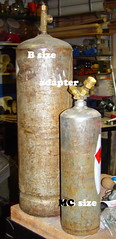DO NOT mess with the regulator, If you have no clue as to what you are doing you can can your family a lot pain and suffering. You don't list where you live the colder the temp outside or the bottle temp the lower the pressure of the gas in the bottle.
If you have bought used tanks, from a private party you may have gotten burned on the tank valve being damaged. Could the acetylene tank that has a tank wrench be a B tank instead of a 40 cuft one.
Does it look like the larger tank

Which is called a bus tank from the old days of being the size they used on the lighting systems for buses. Now used as an tank for air/acetylene torches.
The valve can be leaking, because it is bent, or the seals are damaged from the repeated cranking down to seal it when closing. @ 70'F the pressure on an acetylene tank is 225psi When full. Because of the low pressure compared to oxygen 2,250psi @70psi.
You open the tank valve no more than one turn, but I was taught in the 60's that ¼ turn works and if there is a problem is faster to turn off.
Because the acetylene tanks valve has only one seat and @ relatively low pressure leak by isn't considered a problem. Oxygen tank valves have two seals and should be opened all the way to seat the back seal to stop any leak by.
And the newer tanks all have valve handles, older tanks (acetylene) had wrenches. As the B and MC sized tanks in the above picture.
If the ambient temp and all other things are ok. best safest and cheapest is find out what the LWS will charge for valve replacement. And check what they will charge for a rebuild of the gauges. And remember always take the pressure off the regulator when you turn off the set up. This prevents problems with the springs, diaphragms and seals on both the regulators.
It also can prevent blow out of the regulator when opening a full fresh tank.
good luck and be safe.
glen